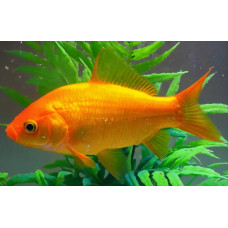Latin name
Carassius auratus
Identification
The body of the goldfish is short and tall with a slightly angular shape. It is barely flattened on the sides and covered with dense, rough scales. There are two lines of varieties among the various breeds that differ in body shape: long-bodied and short-bodied.
Features of fish fins
The last unbranched ray of each of the dorsal and anal fins has 15 enlarged denticles. The upper margin of the dorsal fin is either slightly notched or straight.
Fish colouring
The original form has a general background colouration of steel and silver. The dorsal area is dark greenish-grey, the sides are greyish-silver and the belly is greyish-blue, sometimes with a yellowish tint. The dorsal, pectoral and caudal fins are grey, while the pelvic and anal fins are grey with a pink tint. The iris of the eye is usually orange. Through artificial selection, a wide variety of colours has been obtained in different breeds, ranging from yellowish-silver and orange to red and black, with various shades in between.
Distribution
Its species distribution includes the waterways of Central Asia, China and Japan. It has also been introduced to many other countries around the world.
Habitat
This freshwater lake-river benthic gregarious resident fish is unpretentious to the environment. It lives in deep floodplain reservoirs with developed vegetation and clear spits (wide areas of water with greater depth than the surrounding area); it avoids overgrown areas.
Size
The maximum body length is 31 cm, the maximum weight is 350 g and the maximum life expectancy is 10–12 years.
Behavior
It is possible to keep them with other non-predatory species of fish, especially ones that are not prone to biting fins. However, it should be remembered that ornamental varieties of goldfish are poorly adapted to competition, including for food.
Food and feeding habits
Its diet consists of plankton, benthos and soft vegetation.
Reproduction
Sexual maturity is reached at 2–3 years of age. Males reach a length of 6.5–10.5 cm and a weight of 30–50 g, while females reach a length of 6.8–11 cm and a weight of 50–80 g. Breeding takes place from late April to mid-August. The fecundity of fish measuring 7–18 cm was 24,000–118,000 eggs. Spawning occurs in batches at water temperatures of 13.5–24.4 °C in warmed, shallow waters. The eggs are sticky and are deposited on vegetation. At a water temperature of 23-25 °C, the larvae emerge 2-2.5 days after the eggs are fertilised.
Aquarium conditions
Maintaining goldfish in an aquarium is not significantly difficult. They live at room temperature and do not require heating. In small vessels, the water needs to be aerated abundantly. The number of fish in an aquarium should be calculated based on 2 litres of volume per adult fish.
When decorating the aquarium, avoid using stones and shells with sharp edges or knots, as there is a high risk of the fish becoming injured. It is preferable to use plants with hard leaves; otherwise, the fish will eat them.
Interesting facts
Look at the way the telescope swims around the aquarium. He is always turning in some direction, trying to swim in circles. This tendency to 'circular swimming' emerged because, in China — the birthplace of the telescope fish — many generations of these fish were kept in vase-shaped aquariums.
| Classification | |
| Phylum | Chordata |
| Class | Actinopterygii |
| Squad | Carassius |
| Family | Cyprinidae |
| Genus | Carassius |
| Species | C. auratus |
| Features | |
| Conservation status | Least Concern |
| Habitat | Pelagic |
| Life span, years | 12 |
| Maximum body weight, kg | 0,35 |
| Maximum length, cm | 31 |
| Sailing speed, m/s | No information |
| Threat to people | Not edible |
| Way of eating | Planktonophage |
Goldfish
Tags: goldfish



